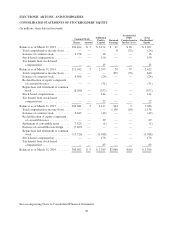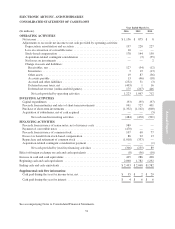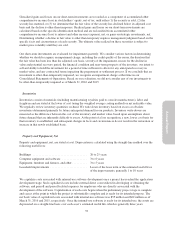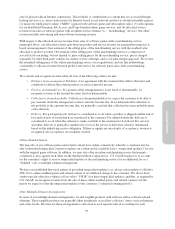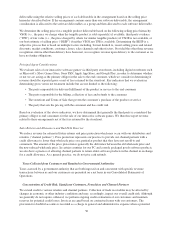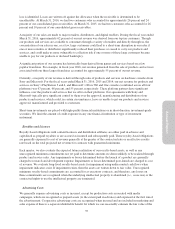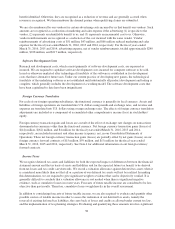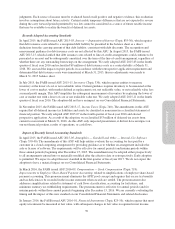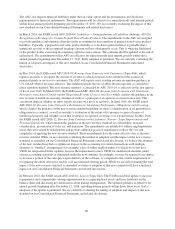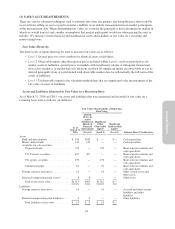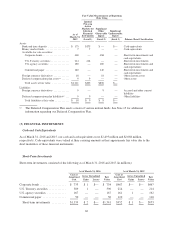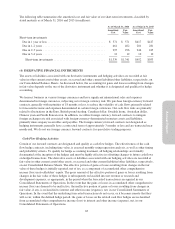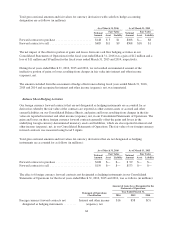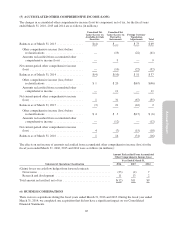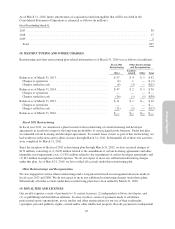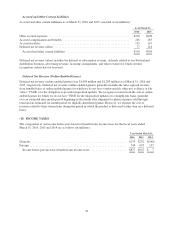Electronic Arts 2016 Annual Report Download - page 146
Download and view the complete annual report
Please find page 146 of the 2016 Electronic Arts annual report below. You can navigate through the pages in the report by either clicking on the pages listed below, or by using the keyword search tool below to find specific information within the annual report.The ASU also impacts financial liabilities under the fair value option and the presentation and disclosure
requirements for financial instruments. The requirements will be effective for annual periods (and interim periods
within those annual periods) beginning after December 15, 2017. We are currently evaluating the impact of this
new standard on our Consolidated Financial Statements and related disclosures.
In March 2016, the FASB issued ASU 2016-04, Liabilities — Extinguishments of Liabilities (Subtopic 405-20):
Recognition of Breakage for Certain Prepaid Stored-Value Products. The amendments in the ASU are designed
to provide guidance and eliminate diversity in the accounting for derecognition of prepaid stored-value product
liabilities. Typically, a prepaid stored-value product liability is to be derecognized when it is probable that a
significant reversal of the recognized breakage amount will not subsequently occur. This is when the likelihood
of the product holder exercising its remaining rights becomes remote. This estimate shall be updated at the end of
each period. The amendments in this ASU are effective for annual periods (and interim periods within those
annual periods) beginning after December 15, 2017. Early adoption is permitted. We are currently evaluating the
timing of adoption and impact of this new standard on our Consolidated Financial Statements and related
disclosures.
In May 2014, the FASB issued ASU 2014-09, Revenue from Contracts with Customers (Topic 606), which
requires an entity to recognize the amount of revenue to which it expects to be entitled for the transfer of
promised goods or services to customers. The ASU will replace most existing revenue recognition guidance in
U.S. GAAP when it becomes effective. The standard permits the use of either the retrospective or cumulative
effect transition method. This new revenue standard, as amended by ASU 2015-14, is effective in the first quarter
of fiscal year 2019. In March 2016, the FASB issued ASU 2016-08, Revenue from Contracts with Customers:
Principal versus Agent Considerations (Reporting Revenue Gross versus Net), which clarifies the guidance in the
new revenue standard on assessing whether an entity is a principal or an agent in a revenue transaction. This
conclusion impacts whether an entity reports revenue on a gross or net basis. In April 2016, the FASB issued
ASU 2016-10, Revenue from Contracts with Customers: Identifying Performance Obligations and Licensing,
which clarifies the guidance in the new revenue standard regarding an entity’s identification of its performance
obligations in a contract, as well as an entity’s evaluation of the nature of its promise to grant a license of
intellectual property and whether or not that revenue is recognized over time or at a point in time. In May 2016,
the FASB issued ASU 2016-12, Revenue from Contracts with Customers:Narrow- Scope Improvements and
Practical Expedients. which amends the guidance in the new revenue standard on collectibility, noncash
consideration, presentation of sales tax, and transition. The amendments are intended to address implementation
issues that were raised by stakeholders and provide additional practical expedients to reduce the cost and
complexity of applying the new revenue standard. These amendments have the same effective date as the new
revenue standard. While we are currently evaluating the method of adoption and the impact of the new revenue
standard, as amended, on our Consolidated Financial Statements and related disclosures, we believe the adoption
of the new standard may have a significant impact on the accounting for certain transactions with multiple
elements or “bundled” arrangements (for example, sales of online-enabled games for which we do not have
VSOE for unspecified future updates) because the requirement to have VSOE for undelivered elements under
current accounting standards is eliminated under the new standard. Accordingly, we may be required to recognize
as revenue a portion of the sales price upon delivery of the software, as compared to the current requirement of
recognizing the entire sales price ratably over an estimated offering period. While we are still evaluating the total
impact of the new revenue standard, as amended, we believe adoption of this new standard will have a material
impact on our Consolidated Financial Statements and related disclosures.
In February 2016, the FASB issued ASU 2016-02, Leases (Topic 842). The FASB issued this update to increase
transparency and comparability among organizations by recognizing lease assets and lease liabilities on the
balance sheet and disclosing key information about leasing arrangements. The updated guidance is effective for
annual periods beginning after December 15, 2018, including interim periods within those fiscal years. Early
adoption of the update is permitted. We are currently evaluating the timing of adoption and impact of this new
standard on our Consolidated Financial Statements and related disclosures.
60


